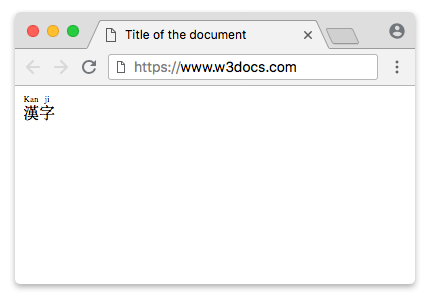The <rt> tag is used to add annotations at the top and bottom of the text, inserted in the <ruby> tag. The <ruby> tag defines a ruby annotation, a pronunciation guide for relatively obscure characters in Japanese or East Asian languages.
The annotation placed in the <rp> tag contains a tip of pronunciation and translation of the basic text (hieroglyphs). Annotation is displayed in a small print above the hieroglyphs.
The <rt> tag is one of the HTML5 elements.
Syntax
The <rt> tag comes in pairs. However the closing tag isn’t required, if it comes the last. The closing tag of the <rt> element may be omitted when <rt> is immediately followed by <rt>, <rb>, <rp> or <rtc>, or when there isn’t any content in the parent element.
Example of the HTML <rt> tag:
<!DOCTYPE html>
<html>
<head>
<title>Title of the document</title>
</head>
<body>
<ruby>
漢 <rt>Kan</rt>
字 <rt>ji</rt>
</ruby>
</body>
</html>Result

Attributes
The <rt> tag supports the Global Attributes and the Event Attributes.
Browser support
|
|
|
|
|
|---|---|---|---|
| 5+ | 38+ | 5+ | 15+ |
Practice Your Knowledge
Quiz Time: Test Your Skills!
Ready to challenge what you've learned? Dive into our interactive quizzes for a deeper understanding and a fun way to reinforce your knowledge.